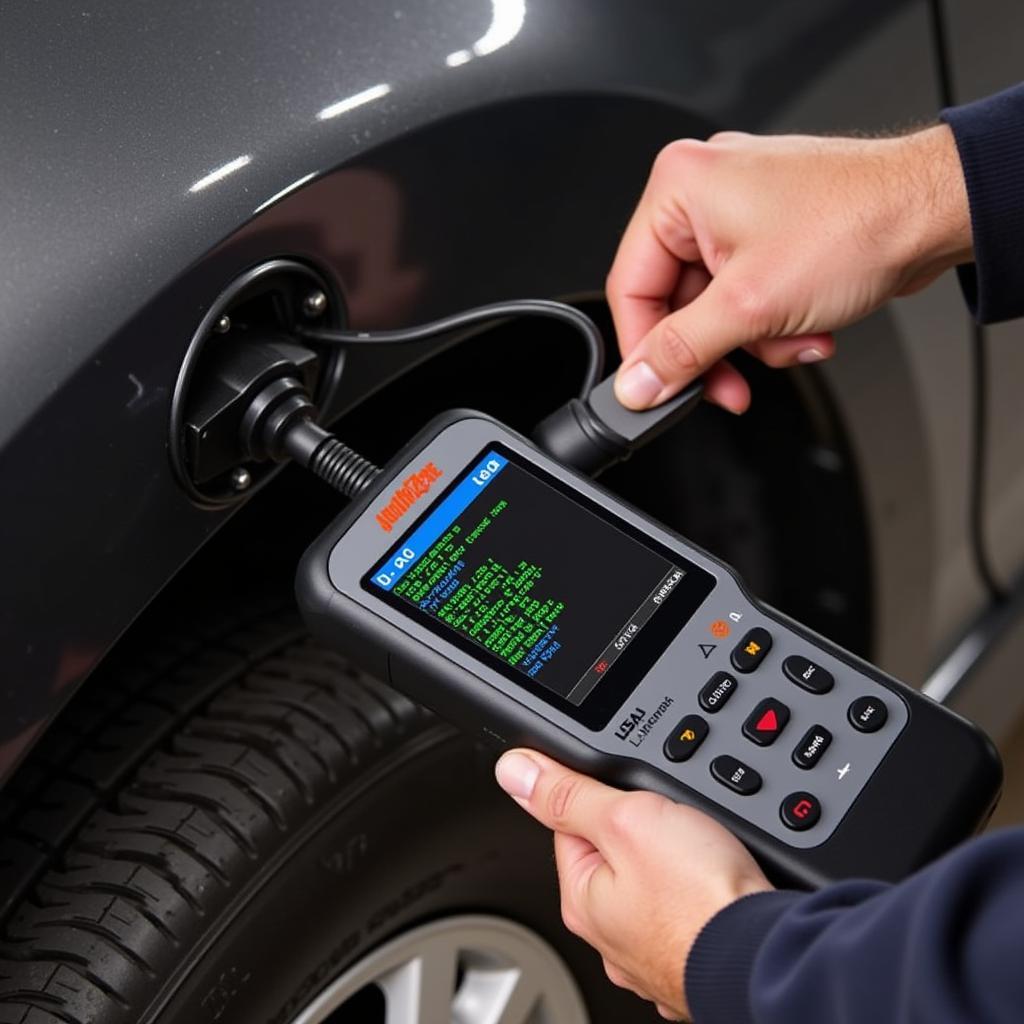Finding the Best Honda Scan Tool can feel like searching for a needle in a haystack, especially with so many options flooding the market. Whether you’re a seasoned mechanic or a Honda enthusiast looking to delve into DIY repairs, having the right diagnostic tool can save you time, money, and unnecessary headaches. This comprehensive guide will equip you with everything you need to know about choosing and using the best Honda scan tool for your needs.
[image-1|best-honda-scan-tools|Best Honda Scan Tools|A diverse array of Honda scan tools neatly arranged on a workbench, showcasing the variety of options available to Honda owners and mechanics.]
Understanding the Importance of a Honda Scan Tool
Modern vehicles, Hondas included, are complex machines controlled by intricate computer systems. These systems, also known as Electronic Control Units (ECUs), manage everything from engine performance and fuel efficiency to safety features and emission controls. When a problem arises, the ECU logs a Diagnostic Trouble Code (DTC) that provides a clue about the issue’s nature.
This is where a Honda scan tool comes in. It acts as a communication bridge between your car’s computer and you, allowing you to:
- Retrieve and interpret DTCs: Understand the meaning behind those cryptic codes and pinpoint the problematic system or component.
- Reset check engine light: Once you’ve addressed the underlying issue, clear the DTCs and turn off the check engine light.
- Access live data stream: Monitor various engine parameters in real-time, such as RPM, coolant temperature, oxygen sensor readings, and more, to diagnose issues effectively.
- Perform advanced functions (depending on the tool): Some scanners offer functionalities like ABS bleeding, key programming, injector coding, and other specialized tasks.
Investing in the best Honda scan tool empowers you to take control of your car’s maintenance and repairs, often saving you costly trips to the mechanic.
Types of Honda Scan Tools: Finding Your Perfect Match
The market offers a wide spectrum of Honda scan tools, each with strengths and limitations catering to different users.
1. Code Readers: Entry-Level Simplicity
As the name suggests, code readers are basic scanners primarily designed to retrieve and clear DTCs. They are an affordable option for casual users who want to understand why their check engine light is on.
Pros:
- Inexpensive and widely available.
- Easy to use, even for beginners.
- Sufficient for basic diagnostics and check engine light reset.
Cons:
- Limited functionality beyond basic code reading and clearing.
- May not provide detailed code descriptions or troubleshooting guidance.
[image-2|honda-code-reader-in-action|Honda Code Reader in Action|A close-up shot of a mechanic’s hand using a code reader plugged into a Honda’s OBD port, displaying a diagnostic trouble code on the screen.]
2. OBD2 Scanners: Striking a Balance
OBD2 scanners offer a step up from basic code readers, providing more detailed information and additional functionalities. They are versatile tools suitable for both DIY enthusiasts and professional mechanics.
Pros:
- Read and clear DTCs from all vehicle systems, not just the engine.
- Display live data streams for more in-depth diagnostics.
- May offer additional features like freeze frame data, readiness monitors, and vehicle identification number (VIN) retrieval.
Cons:
- Can vary significantly in price and features, making it essential to choose carefully.
- May not support all advanced functions or Honda-specific diagnostics.
3. Professional-Grade Honda Scanners: The Powerhouse
Professional-grade Honda scanners are the top-of-the-line tools designed for experienced mechanics and dealerships. They boast advanced functionalities and comprehensive diagnostic capabilities tailored explicitly for Honda vehicles.
Pros:
- Access all vehicle systems and ECUs for complete diagnostics.
- Perform bi-directional controls, allowing you to test components and systems actively.
- Conduct advanced functions like key programming, module coding, and ECU flashing.
- Provide detailed repair information, wiring diagrams, and technical service bulletins (TSBs).
Cons:
- Significantly more expensive than other scanner types.
- May require specialized training and knowledge to utilize fully.
Choosing the Best Honda Scan Tool: Key Factors to Consider
With the plethora of options available, selecting the best Honda scan tool for your specific needs can seem daunting. Here are crucial factors to guide your decision:
1. Your Skill Level and Intended Use
- Casual User: A basic code reader or an entry-level OBD2 scanner will suffice if you only need to check and clear engine codes occasionally.
- DIY Enthusiast: An OBD2 scanner with live data streaming, freeze frame data, and some advanced functions will equip you to diagnose and address various car problems.
- Professional Mechanic: A professional-grade Honda scanner offering comprehensive diagnostics, bi-directional controls, and advanced functionalities is indispensable.
2. Vehicle Compatibility
Ensure the scan tool you choose is compatible with your Honda’s model year. Older models (pre-1996) may require specific connectors or adapters.
3. Features and Functionalities
- Live Data Streaming: Essential for real-time monitoring of engine parameters and diagnosing intermittent problems.
- Freeze Frame Data: Captures a snapshot of the engine’s operating conditions when a DTC is triggered, aiding in pinpointing the issue’s root cause.
- ABS/SRS Coverage: Check if the tool supports diagnostics for the Anti-lock Braking System (ABS) and Supplemental Restraint System (SRS), crucial for safety-related concerns.
- Bi-directional Controls: Allows active testing of components like actuators, solenoids, and relays to verify their functionality.
- Advanced Functions: Consider your need for key programming, module coding, ECU flashing, or other specialized tasks.
4. Software Updates
Regular software updates are crucial to ensure compatibility with newer vehicle models and access to the latest features and bug fixes. Check the update policy and costs associated with the scan tool.
5. User Interface and Ease of Use
The scan tool should have an intuitive user interface, a clear display, and easy navigation. Look for features like a built-in help menu, troubleshooting guides, or online resources.
6. Brand Reputation and Customer Support
Choose a reputable brand known for producing reliable and accurate diagnostic tools. Check online reviews and consider the availability of technical support and warranty options.
Getting the Most Out of Your Honda Scan Tool
Having the best Honda scan tool is only half the battle. Knowing how to use it effectively is equally important. Here are some tips to maximize its potential:
- Read the Manual: Familiarize yourself with the tool’s features, functionalities, and navigation menus.
- Start with the Basics: Begin by understanding how to read and clear DTCs, then gradually explore more advanced functions.
- Utilize Online Resources: Numerous online forums, tutorials, and videos offer guidance on using specific scan tool models and interpreting diagnostic data.
- Consult a Professional: Don’t hesitate to seek help from a qualified mechanic if you encounter complex issues beyond your expertise.
Conclusion
Choosing the best Honda scan tool can be a game-changer for maintaining and repairing your beloved vehicle. By carefully considering your needs, budget, and the factors discussed above, you can find the perfect diagnostic companion to keep your Honda running smoothly for years to come. Remember, a well-informed car owner is an empowered car owner.
For expert advice and assistance in selecting the perfect Honda scan tool, contact ScanToolUS at +1 (641) 206-8880 or visit our office at 1615 S Laramie Ave, Cicero, IL 60804, USA.
2004 crv scan tool port can be particularly helpful if you’re working with an older model.


